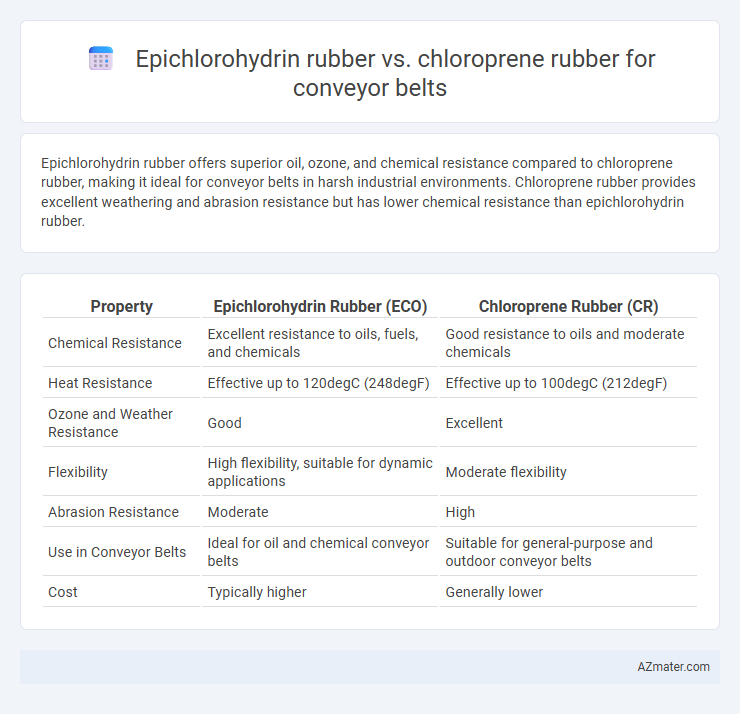Epichlorohydrin rubber offers superior oil, ozone, and chemical resistance compared to chloroprene rubber, making it ideal for conveyor belts in harsh industrial environments. Chloroprene rubber provides excellent weathering and abrasion resistance but has lower chemical resistance than epichlorohydrin rubber.
Table of Comparison
| Property | Epichlorohydrin Rubber (ECO) | Chloroprene Rubber (CR) |
|---|---|---|
| Chemical Resistance | Excellent resistance to oils, fuels, and chemicals | Good resistance to oils and moderate chemicals |
| Heat Resistance | Effective up to 120degC (248degF) | Effective up to 100degC (212degF) |
| Ozone and Weather Resistance | Good | Excellent |
| Flexibility | High flexibility, suitable for dynamic applications | Moderate flexibility |
| Abrasion Resistance | Moderate | High |
| Use in Conveyor Belts | Ideal for oil and chemical conveyor belts | Suitable for general-purpose and outdoor conveyor belts |
| Cost | Typically higher | Generally lower |
Introduction to Conveyor Belt Rubber Materials
Epichlorohydrin rubber offers superior resistance to oils, chemicals, and weathering, making it ideal for conveyor belts exposed to harsh industrial environments. Chloroprene rubber, known for its excellent abrasion resistance and moderate chemical stability, provides durability and flexibility under varying temperatures. Both materials are critical in conveyor belt applications, with Epichlorohydrin favored for chemical resistance and Chloroprene for mechanical robustness.
Overview of Epichlorohydrin Rubber
Epichlorohydrin rubber (ECO) exhibits superior oil, chemical, and ozone resistance, making it highly suitable for conveyor belts in harsh industrial environments. Its excellent heat resistance and low gas permeability enhance durability and reduce material degradation during continuous operation. Compared to chloroprene rubber, ECO offers better resistance to oils and chemicals, providing longer service life and improved performance under demanding conditions.
Overview of Chloroprene Rubber
Chloroprene rubber (CR), also known as Neoprene, features excellent resistance to oil, chemicals, and weathering, making it highly suitable for conveyor belts operating in harsh industrial environments. Its balanced mechanical properties, combined with good heat and ozone resistance, provide durability and flexibility crucial for continuous belt movement. While epichlorohydrin rubber offers superior oil resistance, chloroprene rubber remains preferred when resilience against abrasion and aging is prioritized in conveyor belt applications.
Key Physical Properties Comparison
Epichlorohydrin rubber (ECO) offers superior resistance to oil, chemicals, and ozone compared to Chloroprene rubber (CR), making it ideal for conveyor belts exposed to harsh environments. ECO exhibits excellent flexibility at low temperatures and higher tensile strength, while CR provides better heat resistance and weathering durability. The choice between ECO and CR for conveyor belts depends on the specific operational conditions, with ECO favored for chemical resistance and CR preferred for thermal stability.
Chemical Resistance in Industrial Environments
Epichlorohydrin rubber offers superior resistance to oils, greases, and aliphatic chemicals, making it ideal for conveyor belts exposed to harsh chemical environments in industrial settings. Chloroprene rubber provides good resistance to ozone, weathering, and moderate chemical exposure but is less resistant to hydrocarbons compared to Epichlorohydrin. Selecting Epichlorohydrin rubber enhances conveyor belt durability and performance in aggressive chemical applications, reducing maintenance and downtime.
Performance Under Temperature Extremes
Epichlorohydrin rubber exhibits superior resistance to ozone, oil, and heat, maintaining flexibility and mechanical properties in temperature ranges from -40degC to 120degC, making it ideal for conveyor belts operating under extreme thermal conditions. Chloroprene rubber (Neoprene) performs well within -30degC to 100degC, offering good weatherability and moderate chemical resistance but tends to lose tensile strength and elasticity at higher temperatures. For conveyor belt applications requiring durability in fluctuating or extreme temperatures, Epichlorohydrin rubber delivers enhanced performance and longevity compared to Chloroprene rubber.
Abrasion and Wear Resistance
Epichlorohydrin rubber exhibits superior abrasion and wear resistance compared to chloroprene rubber, making it ideal for conveyor belts exposed to harsh conditions and abrasive materials. Its enhanced molecular structure provides excellent durability and resistance to mechanical degradation, extending belt life and reducing maintenance costs. Chloroprene rubber, while offering good chemical resistance, generally falls short in abrasion resistance, leading to faster wear under heavy-duty conveyor applications.
Cost and Availability Analysis
Epichlorohydrin rubber offers moderate cost efficiency but faces limited availability compared to widely produced and readily available chloroprene rubber, which often reduces lead times for conveyor belt manufacturing. Chloroprene rubber delivers a balance of price and consistent supply, making it a cost-effective choice for large-scale conveyor belt applications. Epichlorohydrin's specialized properties can justify its higher expense in niche uses despite its constrained market presence.
Suitability for Specific Conveyor Belt Applications
Epichlorohydrin rubber offers excellent resistance to oils, chemicals, and weathering, making it ideal for conveyor belts in highly abrasive and oil-exposed environments such as automotive and chemical industries. Chloroprene rubber excels in mechanical strength, flame resistance, and ozone stability, suitable for general-purpose conveyor belts handling moderate abrasion and outdoor applications. Choosing between Epichlorohydrin and Chloroprene depends on the specific operational demands, including exposure to chemicals, temperature ranges, and mechanical stress.
Conclusion: Choosing the Optimal Rubber Material
Epichlorohydrin rubber offers superior resistance to oils, ozone, and weathering, making it ideal for conveyor belts in harsh chemical environments. Chloroprene rubber excels in abrasion resistance and flexibility, suitable for moderate conditions with exposure to weather and mechanical stress. Selecting the optimal rubber material depends on the conveyor belt's operational environment, prioritizing epichlorohydrin for chemical durability and chloroprene for general-purpose abrasion resistance.

Infographic: Epichlorohydrin rubber vs Chloroprene rubber for Conveyor belt
 azmater.com
azmater.com